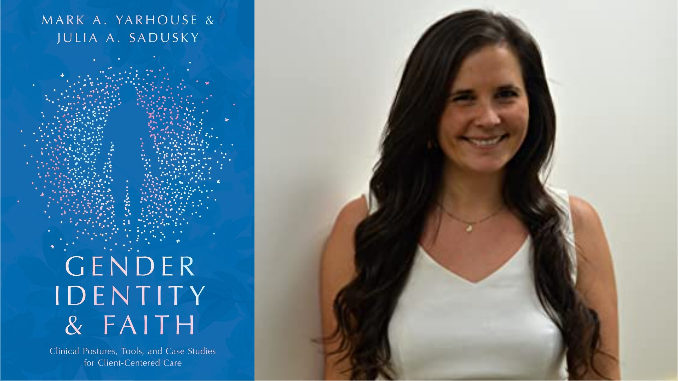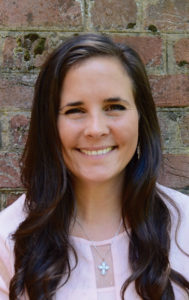
Podcast (beyond-the-page): Play in new window | Download
Subscribe: Apple Podcasts | RSS
Gender identity has recently become part of the “culture war” battles that play out in the media, in our culture, and in our churches. How should Christians respond? How should we talk about the concept of gender identity? How do we have substantive and helpful dialogue and not fall victim to the culture war? How are Christian clinicians supposed to handle issues of gender identity? Gender Identity and Faith offers a blueprint for people to navigate gender-identity questions. In this podcast interview, Dr. Julia Sadusky talks about the book and about how to understand those with diverse gender identities.
The Conversation | Julia Sadusky
This excerpt has been lightly edited for clarity and content. Listen to the full interview at the link above.
Josh Olds: So the book is Gender Identity and Faith. Tell me a little bit about what the book is about, who it is written for, and what you hope to accomplish through it?
Julia Sadusky: Yes, so Gender Identity and Faith is really a book for clinicians. So, if you’re listening and you know therapists, or you yourself are a therapist, this is your book for how we effectively meet the needs of clients coming in for, whom faith is a very important facet of their life, or has been a part of their life for some time, and they’re trying to figure out what it looks like to integrate my experience of gender in keeping with my beliefs and values? And how do I do that in a balanced kind of gradual way, as opposed to believing that there’s only one way to resolve my experience of gender identity. And so that’s more of the framework of the book.
What we’re hoping to accomplish is give clinicians who are well-meaning, who are working with conventionally religious people and their families, concrete tools to develop more of a posture and a confident approach to how they’re engaging with gender minorities in therapy. What we were seeing and continue to see a lot—Mark Yarhouse and I, when we do trainings—is just a real trepidation and fear among clinicians of how do we do right by people in this space, and especially people who may have questions about some of the socio-cultural shifts that we’ve seen in the last 20 years. And so really, equipping clinicians is the goal, and doing so in a balanced psychologically-minded way that is ethical, which doesn’t always happen when clinicians have their own anxieties about how to how to do right by people.
Josh Olds: It’s difficult because the way in which we talk about gender identity or sexual minorities as a society—it comes in the context of what we call the culture wars, and that never foments good discussion. It’s an issue we’ve seen politicized, a gets so much so—bathroom bills, sports participation, and pronouns is like the trifecta. And just if you mentioned the word pronouns, you’re going to get a whole section of Twitter angry at you for that. And you’re like, we’re not having any discussion of meaning or substance, and the humanity of people, regardless of their gender experience, is being lost in the middle of this. What can we do to get rid or push away those less helpful conversations and begin to cultivate more helpful conversations?
Julia Sadusky: Well, I think the first step is what you’re doing right there, Josh, which is recognizing how easily we can get swept up in that. And I think on the front end, it will be catching ourselves when we start to feel ourselves get angry about some debate. So, somebody talks about their own gender identity, or that of a friend, maybe your child comes home from school and says, “Oh, Mom, my friend today said they’re non-binary.” And you start to feel that activation happening, the anger, the frustration, the fear response, what does this mean about the culture and where we’re moving? And we need to really slow that down and think “Oh, my gosh, I’m responding to my kiddo right now. How do I show them that I want them talking about these things with me?” And so, if I respond with anger, if I respond with fear, if I respond with dismissiveness, then my child is probably not going to look to me as a resource in their conversation. They’re going to look to the dominant narratives in the culture. And so to your point, recognizing when we start to do that, slowing that down, even as something as simple as taking a few deep breaths, and saying oh, “Okay, my child is telling me about a friend at their school and something that friend told them about today. How do I be nonreactive in this moment?”
I think we’ve done a little bit more work thinking about our position on gender theory as Christians…and a lot less on how do we effectively engage with real people. – Julia Sadusky
How do we communicate a position about norms of sex and gender, that are in keeping with our Christian beliefs, and do that while also communicating a posture to people who are exploring and actively asking these questions?…And what is Christ calling me to in the particular relationships with people he puts in my path? I think we’ve done a little bit more work thinking about our position on gender theory as Christians, which I am not opposed to, and I think there’s value to that, and a lot less on how do we effectively engage with real people. And that would be a much more fruitful thing to take to prayer, I think then, simply the fears and anxieties about some of the socio-political shifts that we’re seeing today.
The Book | Gender Identity and Faith
 Helping people navigate gender identity questions today is complex and often polarized work. For clients and families who are also informed by their faith, some mental health approaches raise more questions than answers. Clinicians need a client-centered, open-ended approach that makes room for gender exploration while respecting religious identity. Gender Identity and Faith carves out clinical space for mental health professionals to help people who wish to take seriously their gender identity, their religious identity, and the relationship between the two. Drawing from their extensive research and experience with clients, Mark Yarhouse and Julia Sadusky provide a timely, practical resource for practitioners. This book
Helping people navigate gender identity questions today is complex and often polarized work. For clients and families who are also informed by their faith, some mental health approaches raise more questions than answers. Clinicians need a client-centered, open-ended approach that makes room for gender exploration while respecting religious identity. Gender Identity and Faith carves out clinical space for mental health professionals to help people who wish to take seriously their gender identity, their religious identity, and the relationship between the two. Drawing from their extensive research and experience with clients, Mark Yarhouse and Julia Sadusky provide a timely, practical resource for practitioners. This book
- emphasizes respect for clients’ journeys, without a single fixed outcome, toward congruence between their gender identity and faith
- describes effective clinical postures, assessment and therapeutic tools, and numerous case studies
- covers needs and characteristics of children, youth, and adult clients
- includes worksheets and prompts for clients and family members
“Integrating personhood and values is no easy feat, especially in our current cultural landscape,” the authors write. Those navigating this intersection need clinicians who seek to understand their unique context and journey alongside them with empathy. This book points the way.
The Author | Mark Yarhouse
 Mark Yarhouse is the Dr. Arthur P. Rech & Mrs. Jean May Rech Professor of Psychology at Wheaton College, where he directs the Sexual & Gender Identity (SGI) institute. He previously served for 11 years as the Hughes Endowed Chair at Regent University.
Mark Yarhouse is the Dr. Arthur P. Rech & Mrs. Jean May Rech Professor of Psychology at Wheaton College, where he directs the Sexual & Gender Identity (SGI) institute. He previously served for 11 years as the Hughes Endowed Chair at Regent University.
The Author | Julia Sadusky
 Julia Sadusky (PsyD, Regent University) works as a clinical psychologist in Denver, Colorado. She also serves as a youth and ministry educator, offering trainings and consultations on the intersection of sexuality, gender, and theology. Her research experiences and clinical training have focused on the study of sexual and gender identity, including providing individual, family, couples, and group therapy for those navigating sexual- and gender-identity concerns. She is an advisor for the Center for Faith, Sexuality & Gender.
Julia Sadusky (PsyD, Regent University) works as a clinical psychologist in Denver, Colorado. She also serves as a youth and ministry educator, offering trainings and consultations on the intersection of sexuality, gender, and theology. Her research experiences and clinical training have focused on the study of sexual and gender identity, including providing individual, family, couples, and group therapy for those navigating sexual- and gender-identity concerns. She is an advisor for the Center for Faith, Sexuality & Gender.
